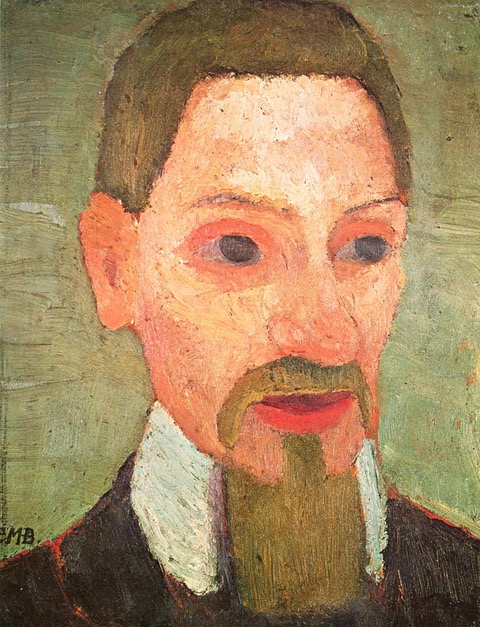Here is a summary of the recent Section for Literary Arts & Humanities meeting of the local group in Fair Oaks, CA. This meeting occurred on April 10, 2021 via Zoom.
“At a Glance . . .”
Our weekly local Literary Arts Section meetings have resumed after a two-week Easter holiday. We will continue our weekly meeting rhythm at least until summer.
This entire evening was devoted to Announcements and Discussion. Briefly summarized, we discussed:
- Rainer Maria Rilke: the Easter issue of the magazine Stil is entirely devoted to the poet Rilke. Stil magazine is a collaborative project of the Section for Literary Arts & Humanities (Schöne Wissenschaften), the Visual Arts Section, and the Section for the Performing Arts at the Goetheanum. It is published quarterly in German by the Verlag am Goetheanum. The Easter issue features articles by Christiane Haid, Peter Selg, Jaap Sijmons, Bruce Donehower, and others. I will discuss this Rilke issue in more detail in the “Tell me more” section and on the website TheLiteraryArts.com. Click this sentence to read the essay “Hearing Rilke” from the magazine Stil. Here is a link to subscription information for Stil.
- National and International news of events in the Section for Literary Arts and Humanities. We discussed several events that are planned for 2021 and 2022, pending what happens with the Covid situation, of course. I will add these to TheLiteraryArts.com website on an ongoing basis, and I will include updates as I become aware of them. Keep your eye on the website for information
- Publication of The Fairies by Ludwig Tieck. This book inaugurates a series of publications to appear under a designated imprint. This first publication is a translation of a story by Ludwig Tieck, one of Novalis’ closest friends. A privately printed edition of this story was gifted to friends and members of the local Fair Oaks group at Christmas 2020. Tieck was instrumental in assuring the publication of Heinrich von Ofterdingen after his friend Novalis died, and he provided invaluable notes about his friend’s intentions for the uncompleted novel. The Fairies can be obtained on Amazon as a Kindle edition or as a trade paperback. More titles (translations and original work) are in production and will appear this year and ongoing. You can read something of what Rudolf Steiner said about Ludwig Tieck on the website
- Springtime guests: Currently we have poet/translator/eurythmist Clifford Venho scheduled to give a presentation on Christian Morgenstern on April 24; Brian Gray with speak about the star configurations around the year 1790 on May 1; and Fred Dennehy will join us on June 5. I am working to invite other guests to our meetings. If any Section friend or member reading this meeting summary might be interested, let me know
- New Moon Salon: On Sunday May 2 we have calendared a New Moon Salon to celebrate the birthday of Friedrich von Hardenberg, the poet Novalis. This salon will feature original music and original translations of poetry. We plan to present poetry by Novalis and Rilke. The program is under development. Details will be forthcoming. Other salons are in preparation
- Artwork above: “Portrait of Rainer Maria Rilke” by Paula Modersohn-Becker, 1906
“Tell me more . . .”
“Grenzgänge . . .” (Boundary Crossings . . . )
The German word at the header of this paragraph — variously translated . . . and please try your hand at your own poetic version — is the title of the Stil Easter edition devoted to Rainer Maria Rilke, and it is also the title of the lead-off article in that issue by Christiane Haid. I found the word used variously in some quick searches on the internet, which by the way turned up what looks to be a passport for Rudolf Steiner.
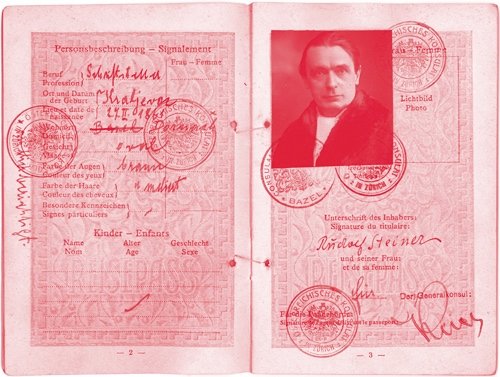
The Borderers
Persons who frequent liminal zones — those who trace, cross, and/or re-cross (transgress) borderlines and boundaries that others take for No Trespass Zones — these are often persons with a keen sensitivity for freedom and a keen sensitivity to the artistic and spiritual dimensions of the being human. Like our young hero Heinrich in the novel by Novalis Heinrich von Ofterdingen — which is a portrait-of-the-artist-as-a-young-man sort of book, one might argue — such persons may freely hover between modes of experience, modes of identity construction, upper and lower worlds — and they often test thresholds and boundaries — for example, the threshold between matter and spirit, life and death. Such threshold experiences were prima materia for the poetry of Rilke. Anyone familiar with the Duino Elegies or the Sonnets to Orpheus or Rilke’s voluminous correspondence such as the famous Letters to A Young Poet knows well that Rilke lived with singleminded devotion to poetry, his muse, and the spirit — much, in fact, like young Heinrich, who is only at the beginning of his poet’s journey in the Novalis novel. (The Borderers, by the way, is the title of a youthful play by William Wordsworth. In previous meetings, we read Schiller’s play, The Robbers — of similar theme.)
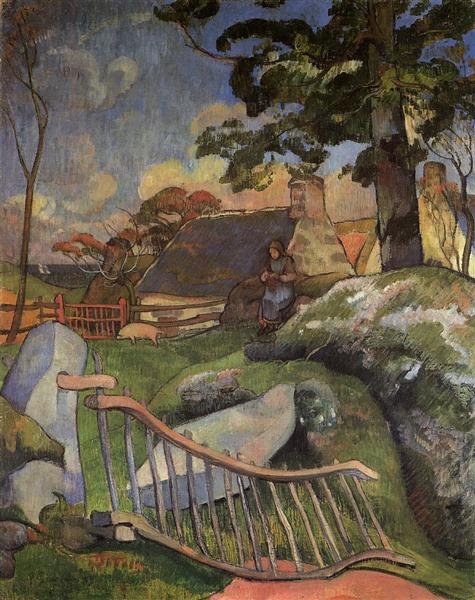
The Wooden Gate (The Pig Keeper) by Paul Gaughin, 1889
The Quest for the “Blue Flower” and for the “Mothers”
As I have said several times previously in these summaries, one of the primary tasks of a lover of literature is to make connections. By reading literature, by writing literature, by inhabiting liminal literary zones, we participate in boundary crossings. Some might even argue, as I have done, that the study of literature — the living into the life literature — develops clairvoyant capacities — empathy and compassion, for example — capacities that assume an ability to read into the experience of the other. That is one reason why authoritarian and repressive societies (or Plato, for example, in his Republic) look askance and with hostility upon poets. This transgressive attitude of the border-walker-poet-shaman challenges constructed norms. But of course, without such challenges those so-called norms become what William Blake referred to as a prison house for the soul.
“A Departure into the Unknown”
Blake, Novalis, Rilke stand in a tradition in that sense — although their metaphors are somewhat different. Blake and Novalis used Christian iconography which they found at hand in the early romantic late eighteenth-century world — Rilke, more transgressive in the spirit of the modernist tradition of the 1920s, did not find affinity with those tropes. All three poets, however, are Orphic, one might argue. To hear the music of Orpheus in their verse empowers us for own own individual boundary explorations, tracings, crossings, and poetry — maybe.
“Experience and the experience of limits — be they limits of understanding, of inner sensation or of purely physical constitution — is often painful. We are thrown back on ourselves in our perception and at the same time intensively experience the presence of the other person. Boundaries always cause an increase of consciousness and their overcoming demands a step into the open, a leaving behind of the previously known and proven — a departure into the unknown.
With Easter we remember the greatest crossing of boundaries: Christ, as a divine being, inhabited a human body and therein experienced death and at the same time overcame it. Earthly existence and death have thus undergone a profound transformation.
Rilke’s life and work is almost paradigmatic for the sounding out and overcoming of boundaries . . .”
— Christiane Haid, excerpted from her Editorial “Grenzgänge”
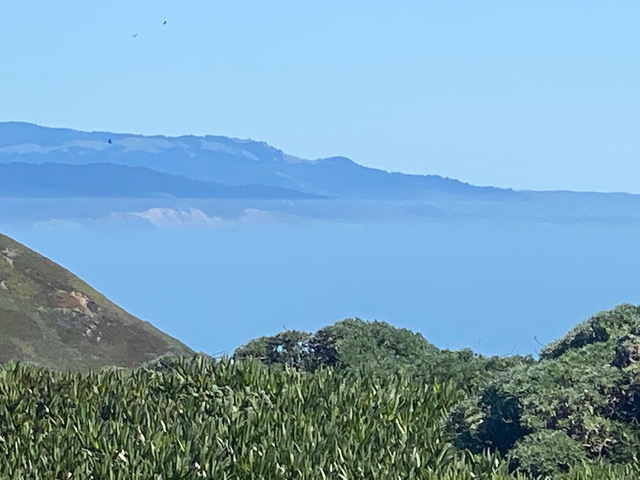
“Marin Landscape, Inverness, CA / Easter 2021” by Bruce Donehower
Redirection to our Website
As we move into the year, I am slowly going to shorten these emailed meeting summaries and instead put more effort of the details of our meetings on TheLiteraryArts.com website, along with other material. A step by step process. So please gradually redirect yourself to the website for more information about:
- Salons
- Section events (national and international)
- Detailed information about recent meetings. (In this case, more about Rilke and Stil.)
- News or reviews of publications
- Ongoing projects here and elsewhere
- Other matters of interest that may arise in the fullness of time
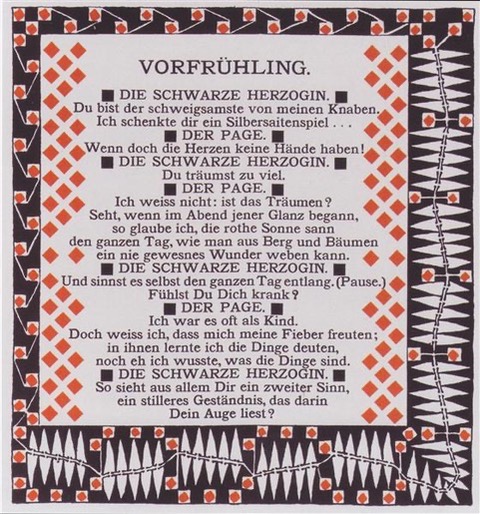
“Early Spring / Illustration for a Poem by Rilke” by Kolomann Moser, 1901
And . . . Announcing:
Poet’s Night! Ta Da!
Our meeting next week on April 17 will feature: Poetry!
Consider this an invitation to read an original poem, an original translation, or a favorite poem by a poet you find inspiring. We’re an intimate enough group that I think we can accommodate everyone in the hour’s time we have at hand. Contact me if you want to read — again, something original or something by someone else. Original poetry will go first, I guess. Based on who contacts me and when, I will put together a list of “poets” and match the offerings to the Time That Is At Hand.
“Friends, the soil is poor. We must scatter abundant seed to assure even a middling harvest.”
— Novalis, Blüthenstaub
“The will-o’-the-wisps rather preferred to make quick exit on a merry joke, but they felt bound to the earth in an incomprehensible manner. It was the most unpleasant sensation they had ever experienced.”
— Goethe, The Fairy Tale
“I want to be with those who know secret things or else alone.”
— Rainer Maria Rilke, from Letters to a Young Poet“Eternity is in love with the productions of time.”
― William Blake, from The Marriage of Heaven and Hell

